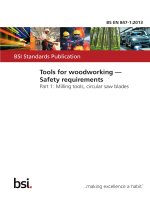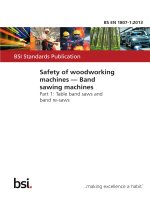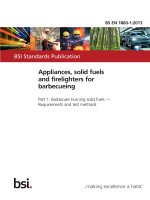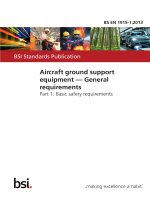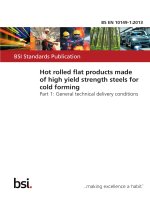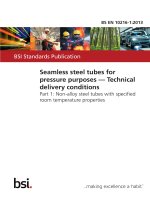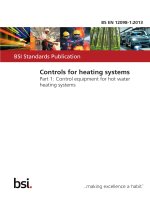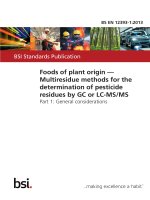Bsi bs en 01591 1 2013
Bạn đang xem bản rút gọn của tài liệu. Xem và tải ngay bản đầy đủ của tài liệu tại đây (1.8 MB, 80 trang )
BS EN 1591-1:2013
BSI Standards Publication
Flanges and their joints —
Design rules for gasketed
circular flange connections
Part 1: Calculation
BS EN 1591-1:2013
BRITISH STANDARD
National foreword
This British Standard is the UK implementation of EN 1591-1:2013. It
supersedes BS EN 1591-1:2001+A1:2009 which is withdrawn.
The UK participation in its preparation was entrusted to Technical
Committee PSE/15/2, Flanges - Jointing materials and compounds.
A list of organizations represented on this committee can be
obtained on request to its secretary.
This publication does not purport to include all the necessary
provisions of a contract. Users are responsible for its correct
application.
© The British Standards Institution 2013. Published by BSI Standards
Limited 2013
ISBN 978 0 580 75631 3
ICS 23.040.60
Compliance with a British Standard cannot confer immunity from
legal obligations.
This British Standard was published under the authority of the
Standards Policy and Strategy Committee on 31 December 2013.
Amendments issued since publication
Date
Text affected
BS EN 1591-1:2013
EN 1591-1
EUROPEAN STANDARD
NORME EUROPÉENNE
EUROPÄISCHE NORM
December 2013
ICS 23.040.60
Supersedes EN 1591-1:2001+A1:2009
English Version
Flanges and their joints - Design rules for gasketed circular
flange connections - Part 1: Calculation
Brides et leurs assemblages - Règles de calcul des
assemblages à brides circulaires avec joint - Partie 1:
Méthode de calcul
Flansche und ihre Verbindungen - Regeln für die Auslegung
von Flanschverbindungen mit runden Flanschen - Teil 1:
Berechnung
This European Standard was approved by CEN on 12 October 2013.
CEN members are bound to comply with the CEN/CENELEC Internal Regulations which stipulate the conditions for giving this European
Standard the status of a national standard without any alteration. Up-to-date lists and bibliographical references concerning such national
standards may be obtained on application to the CEN-CENELEC Management Centre or to any CEN member.
This European Standard exists in three official versions (English, French, German). A version in any other language made by translation
under the responsibility of a CEN member into its own language and notified to the CEN-CENELEC Management Centre has the same
status as the official versions.
CEN members are the national standards bodies of Austria, Belgium, Bulgaria, Croatia, Cyprus, Czech Republic, Denmark, Estonia,
Finland, Former Yugoslav Republic of Macedonia, France, Germany, Greece, Hungary, Iceland, Ireland, Italy, Latvia, Lithuania,
Luxembourg, Malta, Netherlands, Norway, Poland, Portugal, Romania, Slovakia, Slovenia, Spain, Sweden, Switzerland, Turkey and United
Kingdom.
EUROPEAN COMMITTEE FOR STANDARDIZATION
COMITÉ EUROPÉEN DE NORMALISATION
EUROPÄISCHES KOMITEE FÜR NORMUNG
CEN-CENELEC Management Centre: Avenue Marnix 17, B-1000 Brussels
© 2013 CEN
All rights of exploitation in any form and by any means reserved
worldwide for CEN national Members.
Ref. No. EN 1591-1:2013 E
BS EN 1591-1:2013
EN 1591-1:2013 (E)
Contents
Page
Foreword ..............................................................................................................................................................5
1
Scope ......................................................................................................................................................7
2
Normative references ............................................................................................................................7
3
3.1
3.2
3.2.1
3.2.2
3.3
3.4
3.4.1
3.4.2
3.4.3
3.4.4
Notation ..................................................................................................................................................7
Use of figures .........................................................................................................................................7
Subscripts and special marks ..............................................................................................................7
Subscripts ..............................................................................................................................................7
Special marks .........................................................................................................................................9
Symbols ..................................................................................................................................................9
Terminology ........................................................................................................................................ 14
Flanges ................................................................................................................................................ 14
Loading ................................................................................................................................................ 14
Load conditions .................................................................................................................................. 14
Compliances........................................................................................................................................ 14
4
4.1
4.2
4.3
4.4
Requirements for use of the calculation method ............................................................................ 22
General ................................................................................................................................................. 22
Geometry ............................................................................................................................................. 22
Material ................................................................................................................................................ 23
Loads ................................................................................................................................................... 23
5
Checking the assembly for a specified initial tightening bolt force (or torque) .......................... 23
6
6.1
6.2
6.2.1
6.2.2
6.2.3
6.2.4
6.3
6.3.1
6.3.2
6.3.3
6.3.4
6.3.5
6.4
6.4.1
6.4.2
6.4.3
6.4.4
6.4.5
Calculation parameters ...................................................................................................................... 24
General ................................................................................................................................................. 24
Flange parameters .............................................................................................................................. 24
General ................................................................................................................................................. 24
Flange ring ........................................................................................................................................... 25
Connected shell .................................................................................................................................. 26
Flexibility-related flange parameters ................................................................................................ 27
Bolt and washer parameters .............................................................................................................. 28
General ................................................................................................................................................. 28
Effective cross-section area of bolts ................................................................................................ 28
Flexibility modulus of bolts ............................................................................................................... 28
Geometric parameters for washers and contact surfaces ............................................................. 28
Flexibility modulus of washers ......................................................................................................... 29
Gasket parameters ............................................................................................................................. 29
General ................................................................................................................................................. 29
Theoretical dimensions ...................................................................................................................... 29
Effective dimensions .......................................................................................................................... 29
Axial flexibility modulus of gasket .................................................................................................... 30
Lever arms ........................................................................................................................................... 32
7
7.1
7.2
7.2.1
7.2.2
7.3
7.4
7.4.1
7.4.2
7.5
7.5.1
Forces .................................................................................................................................................. 33
General ................................................................................................................................................. 33
Applied loads ...................................................................................................................................... 33
Assembly condition (I = 0) ................................................................................................................. 33
Subsequent conditions (I = 1, 2 …) ................................................................................................... 33
Compliance of the joint ...................................................................................................................... 34
Minimum forces necessary for the gasket ....................................................................................... 35
Assembly condition (I = 0) ................................................................................................................. 35
Subsequent conditions (I = 1, 2, ….) ................................................................................................ 35
Internal forces in assembly condition (I = 0).................................................................................... 35
Required forces................................................................................................................................... 35
2
BS EN 1591-1:2013
EN 1591-1:2013 (E)
7.5.2
7.6
Accounting for bolt-load scatter at assembly .................................................................................. 36
Internal forces in subsequent conditions (I = 1, 2, …) .................................................................... 37
8
8.1
8.2
8.3
8.4
8.5
8.6
Load limits ............................................................................................................................................ 38
General ................................................................................................................................................. 38
Bolts ...................................................................................................................................................... 38
Gasket ................................................................................................................................................... 39
Integral flange and collar .................................................................................................................... 39
Blank flange ......................................................................................................................................... 41
Loose flange with collar...................................................................................................................... 42
Annex A (informative) Dimensions of standard metric bolts ....................................................................... 43
Annex B (informative) Tightening ................................................................................................................... 44
B.1
Scatter of initial bolt load of a single bolt — Indicative values ε1- and ε1+ for a single bolt ......... 44
B.2
Scatter for the global load of all the bolts......................................................................................... 44
B.3
Manual uncontrolled tightening ......................................................................................................... 45
B.4
Assembly using torque wrench ......................................................................................................... 45
B.5
Assembly using bolt tensioner .......................................................................................................... 46
Annex C (informative) Flange rotations .......................................................................................................... 48
C.1
General ................................................................................................................................................. 48
C.2
Use of flange rotation.......................................................................................................................... 48
C.3
Calculation of flange rotations ........................................................................................................... 48
Annex D (informative) Use of the calculation method ................................................................................. 50
D.1
Calculation method principle ............................................................................................................. 50
D.2
Mechanical model................................................................................................................................ 51
D.3
Required checks .................................................................................................................................. 52
D.4
Calculation sequence.......................................................................................................................... 52
Annex E (informative) Gasket/flange face friction coefficients examples .................................................. 54
Annex F (normative) Determination of ∆eGc,I based on a given PQR ............................................................. 55
F.1
Determination of the deflection occurring during a PQR test .......................................................... 55
F.2
Determination of the deflection to be taken into account in the calculation ................................ 56
Annex G (informative) Sealing gasket parameter when no leakage rate is specified ............................... 57
Annex H (informative) Alternative calculation procedure taking into account the plastic
deformation of the gasket in subsequent load conditions procedures (after assembly) ............ 58
H.1
Introduction .......................................................................................................................................... 58
H.2
Calculation procedure......................................................................................................................... 58
H.2.1 General description ............................................................................................................................. 58
H.2.2 No additional plastic deformation ..................................................................................................... 59
H.2.3 Additional plastic deformation ........................................................................................................... 59
H.3
Flat gaskets .......................................................................................................................................... 59
H.3.1 Flat gaskets with small or median deformations ............................................................................. 59
H.3.2 Flat gaskets with greater deformations ............................................................................................ 61
H.4
Metal gaskets with curved surfaces (Figures 3b, c, e, f ) ................................................................ 62
H.5
Metal gaskets with octagonal section (Figure 3d) ........................................................................... 62
Annex I (informative) Available, incomplete models for conversion of the leakage rates in
different conditions (based on certain flow models) ....................................................................... 63
I.1
Introduction and warning ................................................................................................................... 63
I.2
Flow theory fundamentals .................................................................................................................. 63
I.2.1
Transport modes ................................................................................................................................. 63
I.2.2
Case of gases ...................................................................................................................................... 64
I.2.3
Case of liquids: Parallel capillary model........................................................................................... 65
I.3
Factors of influence on the leakage rate of gaskets and gasketed joints ..................................... 65
I.3.1
List of identified factors ...................................................................................................................... 65
I.3.2
Limits and restriction of the proposed models ................................................................................ 65
I.3.3
Dependence on pressure ................................................................................................................... 66
I.3.4
Dependence on temperature .............................................................................................................. 67
3
BS EN 1591-1:2013
EN 1591-1:2013 (E)
I.3.5
I.3.6
I.3.7
I.3.8
I.3.9
I.3.10
I.4
I.4.1
I.4.2
I.4.3
Dependence on the type of fluid ....................................................................................................... 68
Influence of the gasket thickness ..................................................................................................... 68
Influence of gasket width ................................................................................................................... 69
Influence of gasket stress .................................................................................................................. 69
Influence of other factors ................................................................................................................... 69
Conclusion on the factors of influence ............................................................................................ 70
Practical application for EN 1591-1 calculations ............................................................................. 70
General ................................................................................................................................................. 70
Determination of a trend for the leakage rate for the flange connection in “actual” from
“reference” conditions ....................................................................................................................... 71
Determination of a trend for the leakage rate for the flange connection in “reference”
from “actual” conditions .................................................................................................................... 72
Annex ZA (informative) Relationship between this European Standard and the Essential
Requirements of EU Directive 97/23/EC ........................................................................................... 74
Bibliography ..................................................................................................................................................... 75
4
BS EN 1591-1:2013
EN 1591-1:2013 (E)
Foreword
This document (EN 1591-1:2013) has been prepared by Technical Committee CEN/TC 74 “Flanges and their
joints”, the secretariat of which is held by DIN.
This European Standard shall be given the status of a national standard, either by publication of an identical
text or by endorsement, at the latest by June 2014, and conflicting national standards shall be withdrawn at
the latest by June 2014.
Attention is drawn to the possibility that some of the elements of this document may be the subject of patent
rights. CEN [and/or CENELEC] shall not be held responsible for identifying any or all such patent rights.
This document supersedes EN 1591-1:2001+A1:2009.
The major changes in comparison with the previous edition include:
correction of load ratio calculation for blind flanges;
integration of spacers (washers);
modification of bolt load ratio calculation;
integration of lateral forces and torsion moments applied on the bolted joint;
integration of an alternative calculation method (more precise) for the determination of the gasket
effective width (informative annex);
integration of the possibility to handle gasket creep/relaxation behaviour through additional deflection;
integration of an informative annex concerning leakage rates conversions;
integration of the possibility to check a bolted flange connection for a specified initial bolt load value;
integration of the possibility to perform a calculation even when no tightness requirement is defined
through basic gasket parameters (Annex G).
This document has been prepared under a mandate given to CEN by the European Commission and the
European Free Trade Association, and supports essential requirements of EU Directive(s).
For relationship with EU Directive(s), see informative Annex ZA, which is an integral part of this document.
EN 1591 consists of several parts:
EN 1591-1, Flanges and their joints — Design rules for gasketed circular flange connections — Part 1:
Calculation
EN 1591-2, Flanges and their joints — Design rules for gasketed circular flange connections — Part 2:
Gasket parameters
CEN/TS 1591-3, Flanges and their joints — Design rules for gasketed circular flange connections — Part
3: Calculation method for metal to metal contact type flanged joint
EN 1591-4, Flanges and their joints — Part 4: Qualification of personnel competency in the assembly of
the bolted connections of critical service pressurized systems
5
BS EN 1591-1:2013
EN 1591-1:2013 (E)
CEN/TR 1591-5, Flanges and their joints — Design rules for gasketed circular flange connections — Part
5: Calculation method for full face gasketed joints
The calculation method satisfies both leak tightness and strength criteria. The behaviour of the complete
flanges-bolts-gasket system is considered. Parameters taken into account include not only basic ones such
as:
fluid pressure;
material strength values of flanges, bolts and gaskets;
gasket compression factors;
nominal bolt load;
but also:
possible scatter due to bolting up procedure;
changes in gasket force due to deformation of all components of the joint;
influence of connected shell or pipe;
effect of external axial and lateral forces and torsion and bending moments;
effect of temperature difference between bolts and flange ring.
The use of this calculation method is particularly useful for joints where the bolt load is monitored when bolting
up. The greater the precision of this, the more benefit can be gained from application of the calculation
method.
According to the CEN-CENELEC Internal Regulations, the national standards organizations of the following
countries are bound to implement this European Standard: Austria, Belgium, Bulgaria, Croatia, Cyprus, Czech
Republic, Denmark, Estonia, Finland, Former Yugoslav Republic of Macedonia, France, Germany, Greece,
Hungary, Iceland, Ireland, Italy, Latvia, Lithuania, Luxembourg, Malta, Netherlands, Norway, Poland, Portugal,
Romania, Slovakia, Slovenia, Spain, Sweden, Switzerland, Turkey and the United Kingdom.
6
BS EN 1591-1:2013
EN 1591-1:2013 (E)
1
Scope
This European Standard defines a calculation method for bolted, gasketed, circular flange joints. Its purpose is
to ensure structural integrity and control of leak tightness. It uses gasket parameters based on definitions and
test methods specified in EN 13555.
The calculation method is not applicable to joints with a metallic contact out of the sealing face or to joints
whose rigidity varies appreciably across gasket width. For gaskets in incompressible materials, which permit
large deformations, the results given by the calculation method can be excessively conservative (i.e. required
bolting load too high, allowable pressure of the fluid too low, required flange thickness too large, etc.).
2
Normative references
The following documents, in whole or in part, are normatively referenced in this document and are
indispensable for its application. For dated references, only the edition cited applies. For undated references,
the latest edition of the referenced document (including any amendments) applies.
EN 13555:2004, Flanges and their joints — Gasket parameters and test procedures relevant to the design
rules for gasketed circular flange connections
3
Notation
3.1 Use of figures
Figure 1 to Figure 14 illustrate the notation corresponding to the geometric parameters. They only show
principles and are not intended to be practical designs. They do not illustrate all possible flange types for
which the calculation method is valid.
NOTE
For standard flange types, e.g as shown in EN 1092 or EN 1759, the relevant figures are the following:
Type 01
Figure 10
Type 02
Figure 12
Type 04
Figure 12
Type 05
Figure 11
Type 07
Figure 12
Type 11
Figure 6
Type 12
Figure 13
Type 13
Figure 14
Type 21
Figures 6 to 9
3.2 Subscripts and special marks
3.2.1 Subscripts
A – Additional (FA, MA)
B – Bolt
7
BS EN 1591-1:2013
EN 1591-1:2013 (E)
C – Creep of gasket (∆eGc)
D – Equivalent cylinder (tapered hub + connected shell) for load limit calculation
E – Equivalent cylinder (tapered hub + connected shell) for flexibility calculation
F – Flange
G – Gasket
H – Hub
I – Load condition identifier (taking values 0, 1, 2 ...)
L – Loose flange, Lateral (FLI)
M – Moment
N – Nut
P – Fluid pressure
Q – Net axial force due to pressure
R – Net axial force due to external force
S – Shell, shear
T – Shell, modified
TG – Torsion (MTG)
X – Flange weakest cross section
W – Washer
∆ – Symbol for change or difference
av – average
c – calculated
d – design
e – effective
i – Interim value
max – maximum
min – minimum
nom – nominal
opt – optimal
req – required
8
BS EN 1591-1:2013
EN 1591-1:2013 (E)
s – non-threaded part of bolt
specified – refers to the case of calculation performed for a given (specified) initial bolt load
t – theoretical, torque, thread
0 – initial bolt-up condition (I = 0, see subscript I)
3.2.2 Special marks
~ – Accent placed above symbols of flange parameters that refers to the second flange of the joint, possibly
different from the first.
3.3 Symbols
Where units are applicable, they are shown in brackets. Where units are not applicable, no indication is given.
2
AB
Effective total cross-section area of all bolts [mm ], Formula (41)
A F, A L
Gross radial cross-section area (including bolt holes) of flange ring, loose flange
2
[mm ], Formulae (10), (13) and (16)
AGe, AGt
Gasket area, effective, theoretical [mm ], Formulae (56), (53)
AQ
Effective area for the axial fluid-pressure force [mm ], Formula (90)
EB, EF, EL EW
Modulus of elasticity of the part designated by the subscript, at the temperature of
the part [MPa]
EG,
Modulus of elasticity of the gasket for unloading/reloading at the considered
temperature, considering the initial compressed thickness [MPa]
FA
Additional external axial force [N], tensile force > 0, compressive force < 0, see
Figure 1, Formulae (92) and (96)
FB
Bolt force (sum of all bolts) [N]
FG
Gasket force [N]
FG∆,
Minimum gasket force in assembly condition [N] that guarantees, after all load
changes, to subsequent conditions the required gasket force, Formulae (105), (106)
FL
Force resulting from the additional radial forces [N], Formula (93) and (104)
FQ
Axial fluid-pressure force [N], Formula (91)
FR
Force resulting from the additional external loads [N], Formula (96)
FX, FY, FZ
Additional forces along X, Y and Z-axis at gasket interface [N], Formulae (92) and
(93)
I
Load condition identifier, for assembly condition I = 0, for subsequent conditions I =
1, 2, 3,...
MA
Resulting external bending moment [N × mm], Figure 1, Formula (94) and (104)
Mt
Bolt assembly torque [N × mm], Formula (B.4)
2
2
9
BS EN 1591-1:2013
EN 1591-1:2013 (E)
Mt,B
Twisting moment [N × mm] applied to bolt shanks as a result of application of the
bolt assembly torque Mt, Formula (B.9)
MTG
Additional external torsion moment due to friction, Formula (95) and (104)
NR
Number of re-assemblies and re-tightenings during service life of joint, Formulae
(119), (2)
P
Pressure of the fluid [MPa], internal pressure > 0, external pressure < 0 (1 bar = 0,1
MPa), Formula (91)
NOTE
P in this standard is equal to the maximum allowable pressure PS according to the PED.
PQR
Creep factor which is the ratio of the residual and the original gasket surface pressure
at load conditions [-] (Annex F).
QG
Mean effective gasket compressive stress [MPa], QG = FG/AGe (57)
QA
Gasket surface pressure at assembly prior to the unloading which is necessary for the
validity of the corresponding Qsmin (L)I in all subsequent conditions [MPa], Formula
(103).The lowest acceptable value for QA is Qmin (L) from EN 13555.
Q0,min
Gasket surface pressure required at assembly prior to the unloading when no specific
leak rate is requested [MPa], replacement of QA in Formula (103), Annex G
Qmin (L)
Minimum level of gasket surface pressure required for tightness class L at assembly
(on the effective gasket area) from EN 13555 test results [MPa] (see 7.4.2 NOTE 1)
Qsmin (L)
Minimum level of gasket surface pressure required for tightness class L in service
conditions (on the effective gasket area) from EN 13555 test results [MPa], Formula
(104)
Qsmax
Maximum gasket surface pressure that can be safely imposed upon the gasket at the
considered temperature without damage [MPa], Formula (65), (70), (75) and (128)
TB, TF, TG, TL, TW
Temperature (average) of the part designated by the subscript [°C] or [K], Formula
(97)
TO
Temperature of joint at assembly [°C] or [K] (usually + 20 °C), Formula (97)
U
T
T
Axial displacement due to thermal effect [mm]; ∆U according to Formula (97)
WF, WL, WX
Resistance of the part and/or cross-section designated by the subscript [N × mm],
Formulae (130), (146), (150), (148)
XB, XG, Xw
Axial flexibility modulus of bolts, gasket, washer [1/ mm], Formulae (42), (63), (43),
(49), (50)
YB,YG, YQ, YR
Axial compliance of the bolted joint, related to FB, FG, FQ, FR [mm/N], Formulae
(99), (100), (101), (102)
ZF, ZL
Rotational flexibility modulus of flange, loose flange [mm
(35), (39), (40)
b0
Width of chamfer (or radius) of a loose flange such that: d7min = d6+2×b0 [mm],
Figure 12, Formula (85)
10
-3
], Formulae (34), (38),
BS EN 1591-1:2013
EN 1591-1:2013 (E)
b F, b L
Effective width of flange, loose flange [mm], Formulae (7) to (14)
bGi, bGe, bGt
Gasket width (radial), interim, effective, theoretical [mm], Formula (51), (55), (64),
(65), (69), (70), (72), (74) and (75)
bKB
Contact widths bolt side [mm], Formula (48)
bW
Width of a washer [mm], Formula (44)
cA, cB, cF, cM, cS
Correction factors [-],Formulae (123) to (127), (28), (134), (135)
d0
Inside diameter of flange ring [mm] and also the outside diameter of central part of
blank flange (with thickness e0), in no case greater than inside diameter of gasket
[mm], Figures 6 to 14
d1
Average diameter of hub, thin end [mm], Figures 6, 7, 13 and 14
d2
Average diameter of hub, thick end [mm], Figures 6, 7, 13 and 14
d3, d3e
Bolt circle diameter, real, effective [mm], Figures 6 to 14, Formula (6)
d4
Outside diameter of flange [mm], Figures 6 to 14
d5, d5t, d5e
Diameter of bolt hole, pierced, blind, effective [mm], Figures 6 to 14, Formulae (4),
(5)
d6
Inside diameter of loose flange [mm], Figures 12, 14
d7
Diameter of position of reaction between loose flange and stub or collar [mm],
Figure 1, Formulae (61) and (84) to (89).
d8
Outside diameter of collar [mm], Figure 12
d9
Diameter of a central hole in a blank flange [mm], Figure 11
dB0, dBe, dBs
Diameter of bolt: nominal diameter, effective diameter, shank diameter [mm], Figure
3, Table A.1
dB2, dB3
Basic pitch diameter, basic minor diameter of thread [mm], see Figure 3
dB4
Maximum possible outside contact diameter between bolt head or nut and flange or
washer [mm], Formula (47)
dGi,dGe, dGt
Diameter of gasket, interim, effective, theoretical [mm], Figure 4, Formula (56),
Table 1
dK1, dK2
Extreme contact diameters (inside, outside) [mm], Formulae (46) and (47)
dG0, dG1, dG2
Real, theoretical inside, theoretical outside contact diameters [mm], Figure 4
dE, dF, dL dS, dX, dw
Average diameter of part or section designated by the subscript [mm], Figures 1
and 6 to 14
dw1, dw2
Inside, Outside diameter of washer [mm], Figure 1, 2
e0
Wall thickness of central plate of blank flange within diameter d0 [mm], Figure 11
11
BS EN 1591-1:2013
EN 1591-1:2013 (E)
e1
Minimum wall thickness at thin end of hub [mm], Figures 6, 7, 13, 14
e2
Wall thickness at thick end of hub [mm], Figures 6, 7, 13, 14
e D, e E
Wall thickness of equivalent cylinder for load limit calculations, for flexibility
calculations [mm], Formulae (17) and (18)
e F, e L
Effective axial thickness of flange, loose flange [mm], Formulae (10), (13) and (16)
eFb
Thickness of flange ring at diameter d3 (bolt position) [mm], Formula (5)
eFt
Thickness of flange ring at diameter dGe (gasket force position), relevant for thermal
expansion [mm], Formula (98)
eG(QG0)
Initial compressed gasket thickness of gasket under contact pressure QG0 [mm],
Formulae (106), (121) can be obtained from the tests according to EN 13555
eG(A)
Compressed gasket thickness of gasket after all the situations (including plastic
deformation) [mm], Formulae (106), (121) and Annex H
eGt
Initial theoretical uncompressed thickness of gasket [mm]
eP, eQ
Part of flange thickness with (eP), without (eQ) radial pressure loading [mm], Figures
6 to 14, such that eP+eQ = eF
eS
Thickness of connected shell [mm], Figures 6 to 10, 12 to 14
eW
Washer thickness [mm], Figure 1, 2
eX
Flange thickness at weak section [mm], Figure 11
fB, fE, fF, fL, fS, fW
Nominal design stress [MPa] of the part designated by the subscript, at design
temperature [°C] or [K], as defined and used in pressure vessel codes (see
Formulae (123), (127), (130) to (133), (140), (145), (146), (148), (150) and (151))
hG, hH, hL
Lever arms [mm], Figure 1, Formulae (81) to (83) and (87) to (89)
hP, hQ, hR, hS, hT
Lever arm corrections [mm], Formulae (77), (79) and (80), (31) and (37), (29), (30)
jM, jS
Sign number for moment, shear force (+1 or 1), Formulae (136) and (137)
kQ, kR, kM, kS
Correction factors, Formulae (32), (33), (138), (139)
lB, ls
Bolt axial dimensions [mm], Figure 2, Formulae (98) and (42)
le
le = lB - lS
lH
Length of hub [mm], Figures 6, 7, 13, 14, Formulae (17), (18)
m
tightness factor for subsequent conditions ( I>0 ) [-], (Annex G)
nB
Number of bolts, Formulae (3), (6), (41), (42)
pB
Pitch between bolts [mm], Formula (3)
pt
Pitch of bolt thread [mm], Table A.1
12
BS EN 1591-1:2013
EN 1591-1:2013 (E)
r0, r1
Radii [mm], Figures 6, 12
r2
Radius of curvature in gasket cross-section [mm], Figure 4
∆U
T
Differential thermal axial expansions [mm], Formula (97)
∆eGc
Additional deflection of the gasket due to creep that can be defined from PQR value
following the method explained in Annex F (Formula F.3). Equal to 0 if no creep of
the gasket is considered, Formulae (105), (106), (120) and (121)
Θ F, Θ L
Rotation of flange, loose flange, due to applied moment [rad], Annex C
Ψ
Load ratio of flange ring due to radial force, Formula (140)
ΨZ
Particular value of Ψ, Formula (130), Table 2
ФB, ФF, ФG, ФL, ФX,
Load ratio of part and/or cross-section designated by the subscript, to be calculated
for all load conditions, Formulae (123), (129), (145), (151), (128), (149), (147)
αB, αF, αG, αL, αW
Thermal expansion coefficient of the part designated by the subscript, averaged
-1
between T0 and TB, TF, TG, TL, TS, TW [K ], Formula (97)
β, γ, δ, ν, κ, λ, x
Intermediate variables, Formulae (19), (25) to (27), (62), (132), (133)
ε1+, ε1-
Scatter of initial bolt load of a single bolt, above nominal value, below nominal
value, Annex B
ε+, ε–
Scatter for the global load of all the bolts above nominal value, below nominal value,
Annex B
µ
Friction factor for bolting, see Annex B
µG
Friction factor between the gasket and the flange facing, Table (E.1) and Formula
(104)
π
Numerical constant ( π = 3,141593)
ρ
Diameter ratio as given in Formula (36)
φG
Angle of inclination of a sealing face [rad or deg], Figure 4, Table 1
φS
Angle of inclination of connected shell wall [rad or deg], Figures 8, 9
13
BS EN 1591-1:2013
EN 1591-1:2013 (E)
3.4 Terminology
3.4.1 Flanges
Integral flange:
Flange attached to the shell either by welding (e.g. neck weld, see Figure 6 to
Figure 9, or slip on weld, see Figure 10 and Figure 13) or cast onto the envelope
(integrally cast flanges, type 21)
Blank or blind flange:
Flat closure, see Figure 11
Loose flange:
Separate flange ring abutting a collar, see Figure 12
Hub:
Axial extension of flange ring, usually connecting flange ring to shell, see Figure 6
and Figure 7
Collar or stub:
Abutment for a loose flange, see Figure 12
3.4.2 Loading
External loads:
Forces and/or moments applied to the joint by attached equipment, e.g. weight
and thermal expansion of pipes
3.4.3 Load conditions
Load condition:
State with set of applied simultaneous loads; designated by I.
Assembly condition:
Load condition due to initial tightening of bolts (bolting up), designated by I = 0
Subsequent condition:
Load condition subsequent to assembly condition, e.g. test condition, operating
condition, conditions arising during start-up and shut-down; designated by I = 1, 2,
3 ...
3.4.4 Compliances
Compliance:
Inverse stiffness (axial), symbol Y, [mm/N]
Flexibility modulus:
Inverse stiffness modulus, excluding elastic constants of material:
axial: symbol X, [1/mm]
rotational: symbol Z, [1/mm ]
14
3
BS EN 1591-1:2013
EN 1591-1:2013 (E)
Figure 1 — Loads and lever arms
Figure 2 — Washer or spacer
15
BS EN 1591-1:2013
EN 1591-1:2013 (E)
le = l B − ls
Figure 3 — Bolts
16
BS EN 1591-1:2013
EN 1591-1:2013 (E)
Figure 4 — Gaskets
Key
1
male flange (tongue)
2
female flange (groove)
3
gasket
Figure 5 — Details for tongue and groove facing
17
BS EN 1591-1:2013
EN 1591-1:2013 (E)
Key
1
2
shell
hub
3
ring
Figure 6 — Weld-neck flanges with cylindrical shells (example 1)
Key
1
2
shell
hub
3
ring
Figure 7 — Weld-neck flanges with cylindrical shells (example 2)
18
